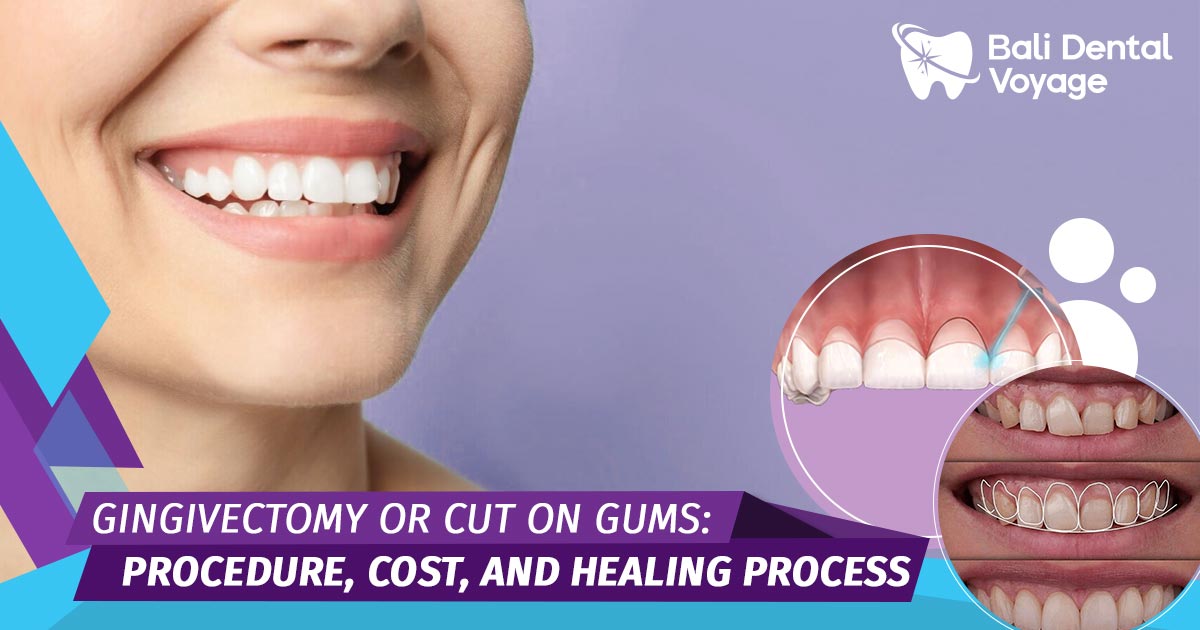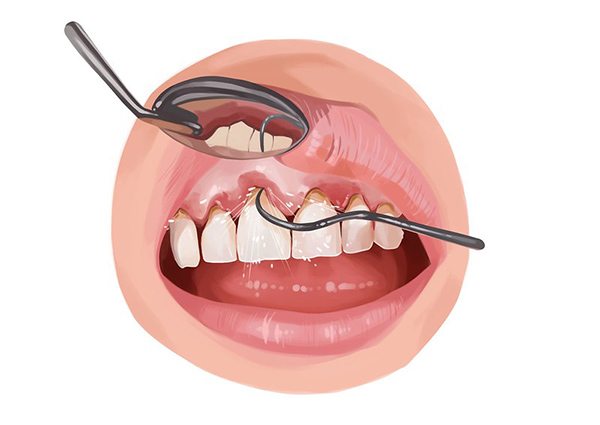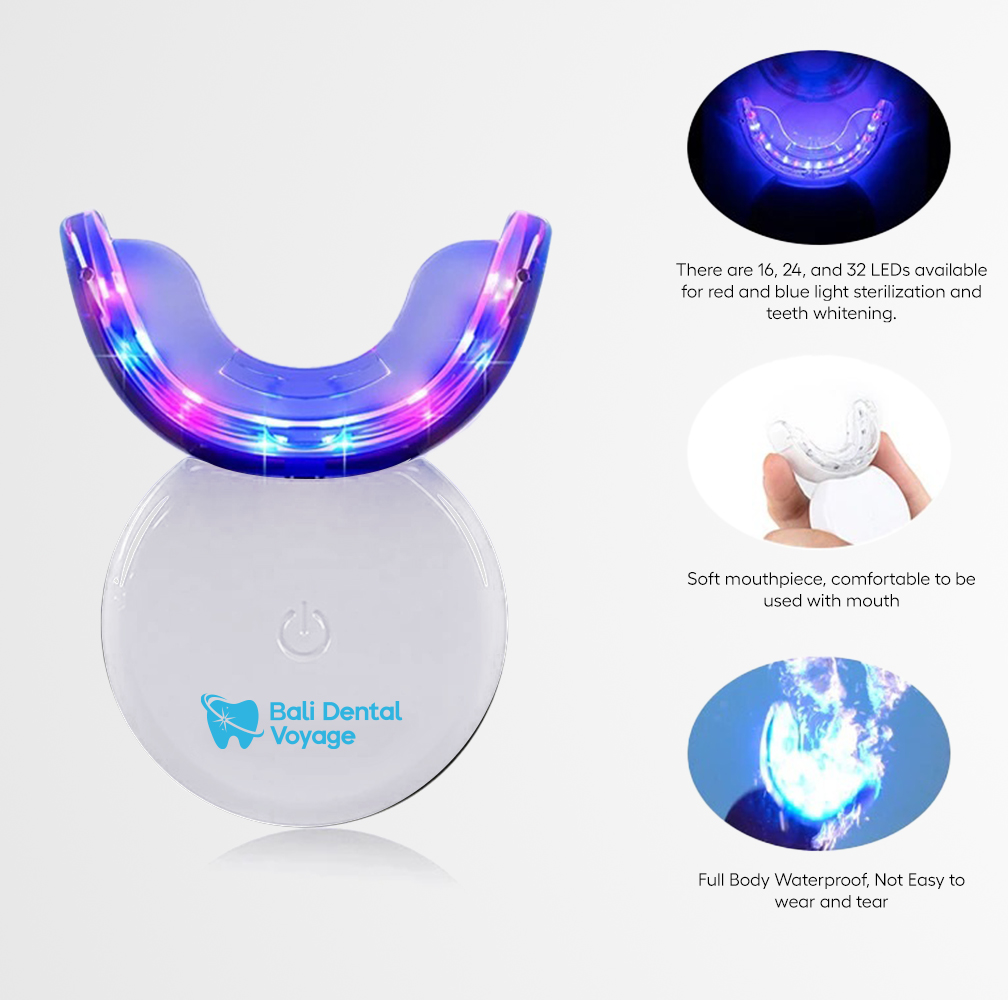
Gingivectomy, also known as periodontal flap surgery or a gum cut, is a surgical procedure that involves removing excess gum tissue and reshaping the gums to improve oral hygiene and treat severe forms of gum disease, such as periodontitis. The procedure is performed by a dentist or periodontist and can help to reduce gum pockets, bleeding, and inflammation, and reduce the risk of tooth loss.
The cost of a gingivectomy can vary, and insurance may cover some or all of the expenses. In this article, we will discuss the gingivectomy including:
- Gingivectomy Procedure
- Gingivectomy Cost
- Gingivectomy Healing Process
- Periodontitis Gingivectomy
- Conclusion
Gingivectomy Procedure
What is Gingivectomy?
Gingivectomy is a dental procedure that involves removing or reshaping excess gum tissue to improve the appearance and health of the gums. This procedure is often performed to treat gum disease, to reduce the risk of periodontal disease, or for cosmetic reasons.
The procedure is performed by a dentist or periodontist and involves cutting the gums to remove the excess tissue and reshape the gum line. Gingivectomy can be done using a scalpel, laser, or electrosurgery, and is usually performed under local anesthesia.
How is the Procedure Performed?
Gingivectomy is performed by a dentist or periodontist and involves cutting the gums to remove the excess tissue and reshape the gum line. The procedure can be done using a scalpel, laser, or electrosurgery, and is usually performed under local anesthesia. During the procedure, the dentist will carefully:
- Remove the excess gum tissue
- Reshape the gum line
- Close the incision
The entire process takes about 30 to 60 minutes, depending on the extent of the procedure. After the procedure, the gums need time to heal, and the dentist will provide instructions for pain management and post-operative care.
Types of Gingivectomy
There are several types of gingivectomy procedures, including:
- Full-Thickness Gingivectomy
It involves removing the entire thickness of the gum tissue and reshaping the gum line. - Partial-Thickness Gingivectomy
It involves removing only part of the gum tissue. - Flap Surgery
It involves lifting the gum tissue and removing the excess tissue before repositioning the flap and suturing it in place.
The type of gingivectomy procedure that is right for you will depend on your specific needs and the extent of the gum tissue to be removed. Your dentist or periodontist will help determine the best type of gingivectomy for your needs.
Preparation for the Procedure
Before undergoing a gingivectomy procedure, patients may need to undergo:
- A comprehensive oral exam
- X-rays
- A deep cleaning
The dentist will also discuss any necessary pre-operative instructions, such as stopping certain medications and avoiding eating or drinking before the procedure. During the pre-operative appointment, the dentist will also discuss the options for managing pain during and after the procedure, and provide instructions for post-operative care. It is important to follow all pre-operative instructions and to provide the dentist with a complete medical history to help ensure the best possible outcome from the gingivectomy procedure.
Gingivectomy Cost

Factors that Affect the Cost
The cost of gingivectomy varies depending on several factors, including:
- The extent of the procedure
- The location of the dental practice
- The type of anesthesia used
Other factors that can affect the cost of gingivectomy include:
- The type of gingivectomy procedure
- The experience and training of the dentist or periodontist
- The use of specialised equipment or materials
Some dental insurance plans may cover part of the cost of a gingivectomy, but it is important to check with your insurance provider to determine your coverage.
It is also a good idea to get a detailed estimate from the dental practice before undergoing the procedure to help ensure that you understand the total cost of a gingivectomy.
Average Cost of Gingivectomy
The cost of a gingivectomy in Bali, Indonesia may vary based on several factors, as outlined in the factors that affect the cost. On average, the cost of a gingivectomy in Bali ranges from IDR 2 million to IDR 8 million. This cost includes the fee for the dentist or periodontist, the use of specialised equipment or materials, and the cost of anesthesia and other related expenses.
However, it is important to keep in mind that these costs are only estimates and the actual cost of a gingivectomy in Bali may vary. To get a more accurate estimate, it is best to contact several dental practices in Bali to compare prices and services.
Insurance Coverage for Gingivectomy
Insurance coverage for gingivectomy varies depending on the type of dental insurance policy you have and the specific details of your coverage. Some dental insurance plans may cover part or all of the cost of a gingivectomy, while others may not provide any coverage. To determine your insurance coverage for gingivectomy, you will need to check with your insurance provider and review your policy details.
Some insurance providers may require a pre-authorisation or referral from your dentist or periodontist before they will provide coverage. In some cases, insurance providers may also require that you meet certain criteria or follow specific guidelines to be eligible for coverage. It is important to understand your insurance coverage for gingivectomy before undergoing the procedure to help ensure that you are prepared for any out-of-pocket expenses.
Payment Options
In Bali, Indonesia, patients who are undergoing gingivectomy have several payment options. These include:
- Cash
- Credit card
- Traveller’s checks
Some dental practices in Bali may also accept insurance, although it is important to check with the practice directly to determine their specific payment options. Additionally, some dental practices in Bali may offer financing or payment plans to help make the cost of gingivectomy more manageable.
Before undergoing a gingivectomy in Bali, it is important to understand the payment options available and to make payment arrangements. This will help ensure that you are fully prepared for any out-of-pocket expenses and can focus on a successful recovery from the procedure.
Gingivectomy Healing Process
What to Expect After the Procedure
After undergoing a gingivectomy procedure, patients can expect some swelling, discomfort, and bleeding in the treated area. This is normal and should subside within a few days to a week. To help manage pain and discomfort, patients may be prescribed pain medication or given over-the-counter pain relief options.
Cold compresses can also help reduce swelling. Patients should also avoid rinsing their mouths or eating solid foods for the first 24 hours after the procedure. It is important to follow the post-operative instructions provided by the dentist or periodontist, including:
- Regular rinsing with salt water
- Avoiding smoking
- Brushing and flossing as directed
Regular follow-up appointments will be scheduled to monitor the healing process and to ensure the best possible outcome from the gingivectomy procedure.
Pain Management
Pain management is an important aspect of the recovery process after a gingivectomy procedure. Patients can expect some discomfort and pain in the treated area after the procedure.
To manage pain, patients may be prescribed pain medication, such as ibuprofen or acetaminophen, or given over-the-counter pain relief options. If pain persists or becomes severe, patients should contact their dentist or periodontist for additional support and advice.
Care Instructions for Healing Gums
Proper care is essential for a successful recovery and healthy healing of the gums after a gingivectomy procedure. As outlined in the What to Expect After the Procedure section, patients need to follow the post-operative instructions given by their dentist or periodontist. Soft, cool foods and plenty of rest and hydration can also aid in the healing process.
In addition, patients should attend all scheduled follow-up appointments to monitor the healing process and ensure proper care is being taken. If any issues arise, such as excessive pain or bleeding, patients should contact their dentist or periodontist immediately for additional support and advice. Proper care and attention during the healing process can help ensure the best possible outcome from the gingivectomy procedure.
Follow-Up Appointments
Follow-up appointments are an important part of the recovery process after a gingivectomy procedure. Regular follow-up appointments with the dentist or periodontist will be scheduled to monitor the healing process and ensure proper care is being taken. During these appointments, the dentist or periodontist will examine the treated area and provide additional care and support as needed.
Follow-up appointments also provide an opportunity for patients to ask any questions they may have and receive advice and guidance on how to properly care for their gums during the healing process. Attending all scheduled follow-up appointments is essential for a successful recovery and a healthy outcome from the gingivectomy procedure.
Periodontitis Gingivectomy

What is Periodontitis?
Periodontitis is a serious gum disease that affects the tissues and bones supporting the teeth. It is caused by a buildup of plaque and bacteria, which can cause inflammation and infection in the gums. Over time, periodontitis can lead to:
- Receding gums
- Loosening of teeth
- Tooth loss
It is important to seek treatment for periodontitis to prevent further damage to the gums and teeth. Treatment options may include:
- Deep cleaning
- Scaling and root planing
- Antibiotics
- In severe cases, gum surgery such as a gingivectomy.
Regular dental check-ups and good oral hygiene practices can help prevent periodontitis and maintain healthy gums.
How is Gingivectomy Used to Treat Periodontitis?
Gingivectomy is a surgical procedure that is used to treat periodontitis, a serious gum disease. The dentist or periodontist will:
- Remove any diseased gum tissue
- Reshape the gums
- Eliminate pockets of bacteria that have formed around the teeth during the procedure
This can help to:
- Reduce inflammation and infection in the gums
- Prevent further damage
- Improve oral health
Gingivectomy is typically performed in conjunction with other periodontal treatments, such as scaling and root planing or antibiotics, to ensure the best possible outcome. The procedure is typically performed under local anesthesia and patients can expect some discomfort and pain after the procedure, which can be managed with pain medication and proper care.
Benefits of Gingivectomy in Treating Periodontitis
Gingivectomy is a surgical procedure used to treat periodontitis, a severe form of gum disease. It involves:
- Removing excess gum tissue
- Reshaping the gums
- Exposing more of the tooth to improve oral hygiene
Benefits of gingivectomy include:
- Reducing gum pockets
- Reducing bleeding and inflammation
- Improving the overall health of the gums
The procedure can also help to restore the appearance of a person’s smile and reduce the risk of tooth loss. In cases of advanced periodontitis, a gingivectomy may be performed in conjunction with other treatments, such as scaling and root planing or bone grafting.
Risks and Complications
Gingivectomy is a surgical procedure to treat periodontitis, but like any surgery, it carries some risks and complications. These can include:
- Bleeding
- Infection
- Pain
- Swelling
- Scarring
There is also a risk of damage to the underlying bone or nerve endings, which can lead to sensitivity or loss of function. Patients need to understand these risks before undergoing a periodontal flap surgery and to discuss them with their dentist.
In some cases, alternative treatments, such as scaling and root planing, may be a better option. To minimise the risks of periodontal flap surgery, it is important to choose a skilled and experienced dentist and to follow post-operative care instructions carefully.
Conclusion
In conclusion, periodontal flap surgery is a surgical procedure that can be used to treat severe forms of gum disease, such as periodontitis. The procedure involves removing excess gum tissue and reshaping the gums to improve oral hygiene and reduce the risk of tooth loss. While periodontal flap surgery is generally safe, it does carry some risks and complications, including:
- Bleeding
- Infection
- Pain
- Sensitivity
The cost of a periodontal flap surgery can vary, but insurance may cover some or all of the expenses, depending on the individual’s coverage. After undergoing a periodontal flap surgery, patients need to follow the post-operative care instructions provided by their dentist to promote proper healing and minimise any risks. In some cases, alternative treatments, such as scaling and root planing, may be a better option, and patients should discuss all of their options with their dentist before making a decision.
Get Pain-Free Dental Care in Bali: Expert Impacted Wisdom Tooth Treatment by a Periodontist
Say goodbye to dental discomfort and hello to a beautiful smile! Get Pain-Free Dental Care in Bali with expert-impacted wisdom tooth treatment from a seasoned periodontist. Experience world-class dental services in a tropical paradise, all while enjoying a stress-free, painless dental voyage. Book your appointment now and take the first step towards a brighter, healthier smile.
Trust us, your dental health deserves the best, and that’s exactly what we’re offering you. Book your Bali Dental Voyage today!




